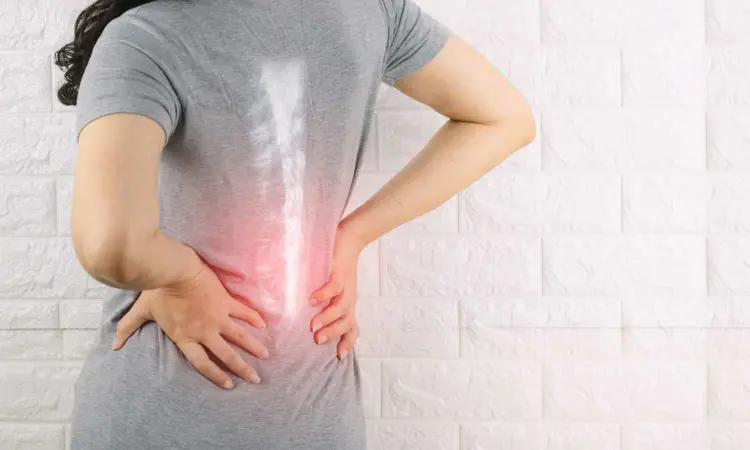- Home
- Medical news & Guidelines
- Anesthesiology
- Cardiology and CTVS
- Critical Care
- Dentistry
- Dermatology
- Diabetes and Endocrinology
- ENT
- Gastroenterology
- Medicine
- Nephrology
- Neurology
- Obstretics-Gynaecology
- Oncology
- Ophthalmology
- Orthopaedics
- Pediatrics-Neonatology
- Psychiatry
- Pulmonology
- Radiology
- Surgery
- Urology
- Laboratory Medicine
- Diet
- Nursing
- Paramedical
- Physiotherapy
- Health news
- Fact Check
- Bone Health Fact Check
- Brain Health Fact Check
- Cancer Related Fact Check
- Child Care Fact Check
- Dental and oral health fact check
- Diabetes and metabolic health fact check
- Diet and Nutrition Fact Check
- Eye and ENT Care Fact Check
- Fitness fact check
- Gut health fact check
- Heart health fact check
- Kidney health fact check
- Medical education fact check
- Men's health fact check
- Respiratory fact check
- Skin and hair care fact check
- Vaccine and Immunization fact check
- Women's health fact check
- AYUSH
- State News
- Andaman and Nicobar Islands
- Andhra Pradesh
- Arunachal Pradesh
- Assam
- Bihar
- Chandigarh
- Chattisgarh
- Dadra and Nagar Haveli
- Daman and Diu
- Delhi
- Goa
- Gujarat
- Haryana
- Himachal Pradesh
- Jammu & Kashmir
- Jharkhand
- Karnataka
- Kerala
- Ladakh
- Lakshadweep
- Madhya Pradesh
- Maharashtra
- Manipur
- Meghalaya
- Mizoram
- Nagaland
- Odisha
- Puducherry
- Punjab
- Rajasthan
- Sikkim
- Tamil Nadu
- Telangana
- Tripura
- Uttar Pradesh
- Uttrakhand
- West Bengal
- Medical Education
- Industry
Abnormal bone mineral density observed in liver cirrhosis patients

A new study published in Journal of Association of The Physicians of India suggests that a large percentage of individuals with liver cirrhosis have abnormal bone mineral density (BMD).
The last stage of chronic liver disease, cirrhosis, causes the normal liver architecture to be distorted by the development of large nodules, vascular reorganization, and the deposition of an extracellular matrix. The term "hepatic osteodystrophy" (HO) describes the changes in bone mineral metabolism that are seen in people with chronic liver illness. Two widely used scoring methods, the CTP score and the model for end-stage liver disease, are used to determine the severity of chronic liver disease. Vaibhav Shukla and his team undertook the current research with the goal of determining how the degree of liver cirrhosis and bone mineral density are related.
It was a case-control investigation. The study comprised 35 confirmed cases of liver cirrhosis and 35 age- and sex-matched controls. Dual-energy X-ray absorptiometry (DEXA) was used to evaluate BMD at the lumbar spine and hip joint. The severity of liver cirrhosis was evaluated using the Child-Turcotte-Pugh (CTP) score.
The key findings of this study were:
1. Twenty-five of the 35 cirrhosis patients exhibited osteopenia or osteoporosis.
2. At the hip joint, the mean T-score in patients was 1.47 by 1.62 and 0.56 by 1.67 in controls (p 0.001).
3. The average T-score found in the lumbar spine was 1.33 1.66 while it was 0.41 1.67 in the control group (p < 0.001).
4. CTP scores and BMD showed a strong unfavorable connection.
This study showed an inverse relationship between BMD and the severity of cirrhosis. Higher CTP scores, lower vitamin D levels, greater PTH levels, and patients with cirrhosis were significant risk factors for aberrant BMD in the current investigation.
Reference:
Shukla V, Fatima J, Siddiqui Z, et al. Study of Correlation of Bone Mineral Density with Severity of Liver Cirrhosis. J Assoc Physicians India. 10.5005/japi-11001-0257
Neuroscience Masters graduate
Jacinthlyn Sylvia, a Neuroscience Master's graduate from Chennai has worked extensively in deciphering the neurobiology of cognition and motor control in aging. She also has spread-out exposure to Neurosurgery from her Bachelor’s. She is currently involved in active Neuro-Oncology research. She is an upcoming neuroscientist with a fiery passion for writing. Her news cover at Medical Dialogues feature recent discoveries and updates from the healthcare and biomedical research fields. She can be reached at editorial@medicaldialogues.in
Dr Kamal Kant Kohli-MBBS, DTCD- a chest specialist with more than 30 years of practice and a flair for writing clinical articles, Dr Kamal Kant Kohli joined Medical Dialogues as a Chief Editor of Medical News. Besides writing articles, as an editor, he proofreads and verifies all the medical content published on Medical Dialogues including those coming from journals, studies,medical conferences,guidelines etc. Email: drkohli@medicaldialogues.in. Contact no. 011-43720751


